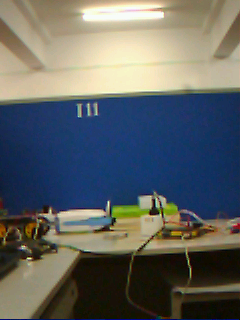基于C语言实现的单片机传输的VGA图像数据生成bmp文件
参考硬件:stm32(但其实是个能带动ov7725有串口的单片机就行)、ov7725,上位机(电脑)
实现原理:ov7725通常输出QVGA/VGA的240*320图像,一个像素点由RBG565(16bits)表示,但常用的电脑bmp像素由BGR888构成(又称bmp24),这需要小小的进行一下像素点的数据处理,然后就是编写电脑串口和bmp文件头实现串口数据接收以及自动生成bmp
建议搜索查阅:因为有点想偷懒,把编写时涉及到的知识点罗列一下(当初在csdn一个个查的,都可以查到很好的解说昂),不再详细解说,见谅
- c语言实现rgb565转bmp24(实现像素点的格式变化)
- c语言调用windows自带库编写串口(实现串口在c语言里的调用,可以存到想存的数组里,不然你把数据用串口助手传到txt里面还真不好弄,他那个是utf8格式)
- c语言生成bmp文件(教你打造bmp文件头,bmp24的文件头最简单了,所以建议先做好数据处理)
- 其他
下面是程序代码,需要更改的地方我用中文表达出来了
#include <stdio.h>
#include <windows.h>
#include <stdlib.h>
#include <string.h>
#include <conio.h>
#include <winnt.h>
#include "rgb2bmp.h"
int main()
{
int cnt;
//char* txtfile="C:\\Users\\17001\\Desktop\\compare2.txt" ;
DWORD dwLength;//unsigned long
unsigned short recvBuf[76800];//定义一个x个16位的数组
DWORD dwactlen;//unsigned long
char psendbuf[32] = "test\n";//定义字符串数组
char ch;//定义字符型变量ch
DCB myDCB;//结构体数组,常用来定义串口
HANDLE m_hComm;//定义一个句柄
m_hComm = CreateFile(
"COM3:",//要打开的文件的名字 (修改为com3)
GENERIC_READ | GENERIC_WRITE, //对设备允许读和写
0, //独占方式(非共享模式)
NULL,
OPEN_EXISTING, //打开而不是创建(创建方式),要求文件必须已存在
0,
NULL
);
if (m_hComm == (HANDLE)-1) //打开串口失败返回
{
printf("打开串口失败");
return 0;
}
//得到打开串口的当前属性参数,修改后再重新设置串口。
if (!GetCommState(m_hComm, &myDCB))
{
printf("GetCommState error");
return FALSE;
}
//设置串口参数
myDCB.BaudRate = CBR_115200; // 设置波特率115200
myDCB.fBinary = TRUE; // 设置二进制模式,此处必须设置TRUE
myDCB.fParity = NOPARITY; // 修改为无奇偶校验
myDCB.fOutxCtsFlow = FALSE; // No CTS output flow control
myDCB.fOutxDsrFlow = FALSE; // No DSR output flow control
myDCB.fDtrControl = DTR_CONTROL_DISABLE; // No DTR flow control
myDCB.fDsrSensitivity = FALSE; // DSR sensitivity
myDCB.fTXContinueOnXoff = TRUE; // XOFF continues Tx
myDCB.fOutX = FALSE; // No XON/XOFF out flow control
myDCB.fInX = FALSE; // No XON/XOFF in flow control
myDCB.fErrorChar = FALSE; // Disable error replacement
myDCB.fNull = FALSE; // Disable null stripping
myDCB.fRtsControl = RTS_CONTROL_DISABLE; //No RTS flow control
myDCB.fAbortOnError = FALSE; // 当串口发生错误,并不终止串口读写
myDCB.ByteSize = 8; // 数据位,范围:4-8
myDCB.Parity = NOPARITY; // 无校验模式
myDCB.StopBits = ONESTOPBIT; // 1位停止位
//设置串口参数
if (!SetCommState(m_hComm, &myDCB))
{
printf("SetCommState error");
return FALSE;
}
SetupComm(m_hComm, 1024, 1024);//设置串口的输入/输出缓冲区大小
PurgeComm(m_hComm, PURGE_RXCLEAR | PURGE_TXCLEAR);
COMMTIMEOUTS TimeOuts;
//设定读超时
TimeOuts.ReadIntervalTimeout = 1000;
TimeOuts.ReadTotalTimeoutMultiplier = 500;
TimeOuts.ReadTotalTimeoutConstant = 5000;
//设定写超时
TimeOuts.WriteTotalTimeoutMultiplier = 500;
TimeOuts.WriteTotalTimeoutConstant = 2000;
SetCommTimeouts(m_hComm, &TimeOuts); //设置超时 !mportant
/*FILE *p = fopen(txtfile,"w") ;
if (p == NULL)
{
printf("open new file failed.n");
return -1;
}*/
ReadFile(m_hComm, recvBuf, 76800*2, &dwLength, NULL);
/*for(cnt=0;cnt<76800;cnt++)
{
fprintf(p,"%d\t",recvBuf[cnt]);
}
fclose(p); */
PurgeComm(m_hComm, PURGE_RXCLEAR | PURGE_TXCLEAR);//清除输出输入缓冲区
CloseHandle(m_hComm); //m_hComm是CreateFile函数返回的串口句柄。
/*convert阶段*/
int nWidth=320;
int nHeight=240;
char* newFile="C:\\Users\\17001\\Desktop\\rgb_new8.bmp";//改成你的路径名和想生成的文件名.bmp
long nData=nWidth*nHeight;//320*240个像素点,long-32bits
long total =nWidth*nHeight*3;//320*240*2字节数
unsigned char* pVisit=(unsigned char*)malloc(total*sizeof(char));//放入新的8位数组里 ,开辟新的数组空间
unsigned char* tmp=pVisit;//记录这个未被修改的指针
unsigned short* rgb_buffer=(unsigned short*)recvBuf;//定义一个可变指针赋值数组地址
long i=0;//32bits
unsigned char R,G,B;
while(i<nData)
{
B = *rgb_buffer&0x1f;//取5位
G = (*rgb_buffer>>5)&0x3f;//取6位
R = (*rgb_buffer>>11)&0x1f;//取5位
B = B<<3;//*8
G = G<<2;//*4
R = R<<3;//*8
*pVisit=B;pVisit++;
*pVisit=G;pVisit++;
*pVisit=R;pVisit++;
rgb_buffer++;
i++;
// printf("%d\n",i);
}
printf("read over.nData%ldn",nData);
/*写阶段*/
FILE *result = fopen(newFile,"wb") ;
if (result == NULL)
{
printf("open new file failed.n");
return -1;
}
RGB2BMP(tmp,nWidth,nHeight,result);
fclose(result);
return 0;
}
以下是头文件,负责生成bmp
//rgb2bmp.h文件
#include <stdio.h>
typedef unsigned char BYTE;
typedef unsigned short WORD;
// BMP图像各部分说明如下
/***********
第一部分 位图文件头
该结构的长度是固定的,为14个字节,各个域的依次如下:
2byte :文件类型,必须是0x4d42,即字符串"BM"。
4byte :整个文件大小
4byte :保留字,为0
4byte :从文件头到实际的位图图像数据的偏移字节数。
*************/
typedef struct
{ long imageSize;
long blank;
long startPosition;
}BmpHead;
/*********************
/*********************
第二部分 位图信息头
该结构的长度也是固定的,为40个字节,各个域的依次说明如下:
4byte :本结构的长度,值为40
4byte :图像的宽度是多少象素。
4byte :图像的高度是多少象素。
2Byte :必须是1。
2Byte :表示颜色时用到的位数,常用的值为1(黑白二色图)、4(16色图)、8(256色图)、24(真彩色图)。
4byte :指定位图是否压缩,有效值为BI_RGB,BI_RLE8,BI_RLE4,BI_BITFIELDS。Windows位图可采用RLE4和RLE8的压缩格式,BI_RGB表示不压缩。
4byte :指定实际的位图图像数据占用的字节数,可用以下的公式计算出来:
图像数据 = Width' * Height * 表示每个象素颜色占用的byte数(即颜色位数/8,24bit图为3,256色为1)
要注意的是:上述公式中的biWidth'必须是4的整数倍(不是biWidth,而是大于或等于biWidth的最小4的整数倍)。
如果biCompression为BI_RGB,则该项可能为0。
4byte :目标设备的水平分辨率。
4byte :目标设备的垂直分辨率。
4byte :本图像实际用到的颜色数,如果该值为0,则用到的颜色数为2的(颜色位数)次幂,如颜色位数为8,2^8=256,即256色的位图
4byte :指定本图像中重要的颜色数,如果该值为0,则认为所有的颜色都是重要的。
***********************************/
typedef struct
{
long Length;
long width;
long height;
WORD colorPlane;
WORD bitColor;
long zipFormat;
long realSize;
long xPels;
long yPels;
long colorUse;
long colorImportant;
/* void show()
{
printf("infoHead Length:%dn",Length);
printf("width&height:%d*%dn",width,height);
printf("colorPlane:%dn",colorPlane);
printf("bitColor:%dn",bitColor);
printf("Compression Format:%dn",zipFormat);
printf("Image Real Size:%dn",realSize);
printf("Pels(X,Y):(%d,%d)n",xPels,yPels);
printf("colorUse:%dn",colorUse);
printf("Important Color:%dn",colorImportant);
}*/
}InfoHead;
/***************************
/***************************
第三部分 调色盘结构 颜色表
对于256色BMP位图,颜色位数为8,需要2^8 = 256个调色盘;
对于24bitBMP位图,各象素RGB值直接保存在图像数据区,不需要调色盘,不存在调色盘区
rgbBlue: 该颜色的蓝色分量。
rgbGreen: 该颜色的绿色分量。
rgbRed: 该颜色的红色分量。
rgbReserved:保留值。
************************/
typedef struct
{ BYTE rgbBlue;
BYTE rgbGreen;
BYTE rgbRed;
BYTE rgbReserved;
/* void show(void)
{
printf("Mix Plate B,G,R:%d %d %dn",rgbBlue,rgbGreen,rgbRed);
}*/
}RGBMixPlate;
/****************************
RGB加上头部信息转换成BMP
参数說明:
rgb_buffer :RGB数据文件中的信息
nData :RGB数据的长度
nWidth :图像宽度的像素数
nHeight :图像高度的像素数
fp1 :所存放的文件
*****************************/
int RGB2BMP(unsigned char *rgb_buffer,int nWidth,int nHeight,FILE*fp1)
{
BmpHead m_BMPHeader;
char bfType[2]={'B','M'};//保留
m_BMPHeader.imageSize=3*nWidth*nHeight+54;//文件字节数,修改
m_BMPHeader.blank=0;//保留
m_BMPHeader.startPosition=54;//位图数据开始位置,修改
fwrite(bfType,1,sizeof(bfType),fp1);
fwrite(&m_BMPHeader.imageSize,1,sizeof(m_BMPHeader.imageSize),fp1);
fwrite(&m_BMPHeader.blank,1,sizeof(m_BMPHeader.blank),fp1);
fwrite(&m_BMPHeader.startPosition,1,sizeof(m_BMPHeader.startPosition),fp1);
InfoHead m_BMPInfoHeader;
m_BMPInfoHeader.Length=40;//本结构长度,保留
m_BMPInfoHeader.width=nWidth;//宽度有多少像素,修改
m_BMPInfoHeader.height=nHeight;//高度有多少像素 ,修改
m_BMPInfoHeader.colorPlane=1;//必须是1,保留
m_BMPInfoHeader.bitColor=24;//表示颜色时用到的位数 ,修改为(24)
m_BMPInfoHeader.zipFormat=0;// 压缩类型,不压缩,保留
m_BMPInfoHeader.realSize=3*nWidth*nHeight;//图像大小,字节为单位
m_BMPInfoHeader.xPels=0;//保留
m_BMPInfoHeader.yPels=0;//保留
m_BMPInfoHeader.colorUse=0;//保留
m_BMPInfoHeader.colorImportant=0;//保留
fwrite(&m_BMPInfoHeader.Length,1,sizeof(m_BMPInfoHeader.Length),fp1);
fwrite(&m_BMPInfoHeader.width,1,sizeof(m_BMPInfoHeader.width),fp1);
fwrite(&m_BMPInfoHeader.height,1,sizeof(m_BMPInfoHeader.height),fp1);
fwrite(&m_BMPInfoHeader.colorPlane,1,sizeof(m_BMPInfoHeader.colorPlane),fp1);
fwrite(&m_BMPInfoHeader.bitColor,1,sizeof(m_BMPInfoHeader.bitColor),fp1);
fwrite(&m_BMPInfoHeader.zipFormat,1,sizeof(m_BMPInfoHeader.zipFormat),fp1);
fwrite(&m_BMPInfoHeader.realSize,1,sizeof(m_BMPInfoHeader.realSize),fp1);
fwrite(&m_BMPInfoHeader.xPels,1,sizeof(m_BMPInfoHeader.xPels),fp1);
fwrite(&m_BMPInfoHeader.yPels,1,sizeof(m_BMPInfoHeader.yPels),fp1);
fwrite(&m_BMPInfoHeader.colorUse,1,sizeof(m_BMPInfoHeader.colorUse),fp1);
fwrite(&m_BMPInfoHeader.colorImportant,1,sizeof(m_BMPInfoHeader.colorImportant),fp1);
fwrite(rgb_buffer,3*nWidth*nHeight,1,fp1);
return 0;
}
注意:按道理来说满足我的硬件条件的相似情况,头文件不用改,c文件大部分不需要改动
有时生成的图片会出现色差,经过串口对比,可能是传输过程中少了一个字节导致像素点错位,解决方法是exe窗口跳出后,单片机稍微等待几秒再发送数据
实验现象:
结语:书写不够正确之处敬请指正,希望学习之路相互交流